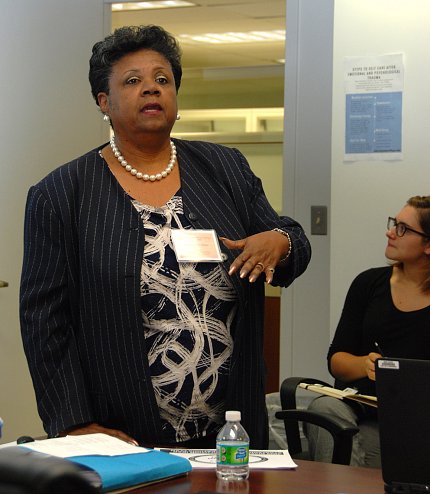Guided by Social Science
Business Model of Diversity, Inclusion Promoted

Photo: Ashley Wells
The idea of diversity has inspired a lot of metaphors for appreciating our differences: Distinctive flavors infusing a melting pot. Melodious voices singing in harmony. Multiple threads forming a tapestry. To be sure, the language brings to mind pleasant images and offers novel ways of looking at employing all of our differences toward the greater good.
These days, though, the workforce marketplace has shifted toward a business view of diversity: How can we use it to achieve our best bottom line? One strategy is—establish an employee resource group (ERG) Community of Practice.
Already in widespread use in many corporate settings, the Community of Practice philosophy—as its name suggests—focuses on engaging employees first, putting workers in a position to advance the collective mission by simultaneously moving their own group and individual interests forward.
Large agencies such as NIH can have as many as 20 or 30 different ERGs tailored to address the unique needs involving employees’ race, nationality, color, gender and disability. For example, Federally Employed Women, Blacks In Government, Deaf Employees Advisory Forum, the Asian and Pacific Islander American Organization and Salutaris have all established homes at NIH over the years.
The NIH Office of Equity, Diversity and Inclusion, which welcomes and helps all such organizations as part of its mission, and the NIH chief officer for scientific workforce diversity (COSWD) want to bring all ERGs together to form a Community of Practice. The strategy encourages groups to consider a broader purpose—helping NIH achieve its mission through strategy.
“There’s a wealth of knowledge and talent within the NIH ERGs and we wish to serve as conduits to expose the diverse thoughts, ideas and talent for the greater good,” explained Debra Chew, EDI director. “Traditionally, EDI—and its predecessor offices—have always developed creative and successful ways of supporting the various employee special emphasis organizations that exist across NIH. Our move to develop a Community of Practice will be no different in that sense—we’ll continue to provide the same strong, consistent support to those groups.”

Photo: Ashley Wells
A Community, however, can benefit both NIH and individual organizations in ways the groups can’t achieve alone. Communities of Practice help with recruitment, for instance, by broadening an agency’s applicant pool. Employee retention also stands to gain through development of an effective Community by providing a consistent, stable environment experienced in handling diverse issues.
Workers who have adopted the Community concept also report feeling better connected to their organization’s leadership and experiencing more ways to network and mentor, said Kay Johnson Graham, a strategist in the EDI Diversity and Inclusion Branch familiar with recent social science research results on ERG Communities.
“If you want to have a real impact,” she said, “then align groups of people who are interested in diversity with the strategies and mission-related work of your organization.”
“Career development will also be an important component of Community development,” explained Ashley Wells, a strategist in EDI’s Special Emphasis Portfolio Branch. That’s just one of the incentives ERG Communities offer to engage employees, she said.
“ERG Communities are really becoming the new training ground for grooming talent,” Graham added. “We’re looking at establishing new leadership opportunities and better succession planning.”
At an inaugural meeting to consider the idea a few months ago, EDI hosted guest presenters Bonita White of HHS and Nicole Lassiter of OPM to discuss ways NIH can adopt the Community model. Representatives from about 20 different NIH ERGs attended, along with Chew and Dr. Hannah Valantine, NIH chief officer for scientific workforce diversity.
“Employee resource groups are vital for our success, since not only do they support community discussion, but also they help connect diverse talent with new scientific opportunities at NIH,” said Valantine.
EDI and COSWD hope to be the bridge between the agency’s burgeoning ERG Community and NIH leadership.
“Adopting the Community framework simply raises our role to a new level,” Chew continued. “It allows NIH as an agency both to keep pace with other federal and corporate organizations and—depending on how we structure our ERG—to move ahead of the field. [The private sector and a few other government agencies] may have a couple of years’ head start on us, but with efficient and effective planning, we can surge ahead on this.”
Currently, EDI is working on the next steps in such a plan. Following the initial meet-and-greet event at which White outlined ERG ground rules and Lassiter discussed best practices, EDI’s Division of Diversity and Inclusion began laying the foundation for forming a Community here to share promising practices in the field and provide support to the ERGs.

Photo: Ashley Wells
One big challenge, they acknowledge, will be buy-in from NIH entities familiar with previous models of employee engagement. But if the success of the first meeting is any indication, most NIH’ers will be eager to be in on the ground floor of a new venture that they can help design.
The next gathering is also in the works, as strategists try to capitalize on the momentum and enthusiasm the inaugural meeting generated.
“The field is changing a lot,” concluded Graham, “and in order to be competitive in attracting and keeping the highest quality workforce, we have to change as well.”
